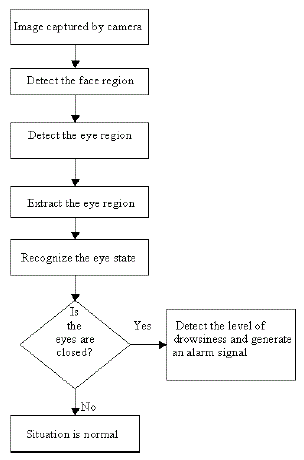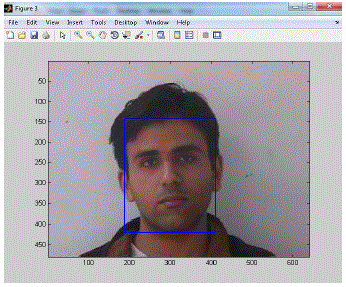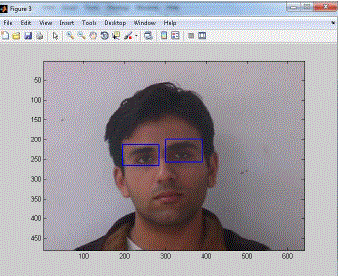In recent years, we have used many technologies to detect the drowsiness of a driver in the field of accident avoidance system [1]-[3]. To develop such a system we need to install some hardware components like camera inside the car, which can capture the image of the driver at a fixed interval, and an alarm system, which will alert the driver after detecting his/her level of drowsiness. Now apart from these hardware components, we need a software part also, which can detect the level of drowsiness of the driver and is the main concern of our paper. It is believed that, driver’s fatigue can be easily detected by monitoring the eye status [5] [7], which is either ‘open’ or ‘closed’. In this paper, we develop a drowsiness detection system that will accurately monitor the open or closed state of the driver’s eyes in real-time.
Keywords |
| Driver’s drowsiness, eye tracking, face detection, fatigue, accident avoidance system |
INTRODUCTION |
| In case of vehicle accidents, driver fatigue is an important factor. Recent statistical report shows that that annually
1,200 deaths and 76,000 injuries can be attributed to fatigue related crashes [1]. Hence development of technologies to
detect the drowsiness property of the driver is a major challenge in the field of accident avoidance systems and also is
an active research area. In literature, there are four types of techniques that are used for detecting drowsiness of drivers. |
A. SENSING OF PHYSIOLOGICAL CHARACTERSTICS |
| Among all these four methods, the most accurate method is based on human physiological phenomena [1]. This
technique is implemented in two ways: measuring changes in physiological signals, such as brain waves, heart rate, and
eye blinking; and measuring physical changes such as sagging posture, leaning of the driver’s head and the open/closed
states of the eyes [1]. Though this technique is most accurate, it is not realistic, since sensing electrodes would have to
be attached directly onto the driver’s body, and hence be annoying and distracting to the driver. In addition, long time
driving would result in perspiration on the sensors, diminishing their ability to monitor accurately. |
B. SENSING OF DRIVER OPERATION |
| The second technique is well suited for real world driving conditions since it can be non-intrusive by using optical
sensors of video cameras to detect changes. |
| In this type of driver’s drowsiness detection system we first capture the face image of the driver using a camera
located inside the car. After that we have to segment only the face region and excluded the background portion. We
may use a very simple approach like color based model to localize a face region. After the localization of the face we
need to extract the eye region. We choose the eye region as our decision parameter because the eye region is very
dynamic in nature and the drowsiness of a person can only be determined by looking at the eyes [7]. If the eye is open,
the situation is normal and if the eye is closed we should generate an alarm signal to alert the driver. |
C. SENSING OF VEHICLE RESPONSE |
| Driver operation and vehicle behavior can be implemented by monitoring the steering wheel movement, accelerator
or brake patterns, vehicle speed, lateral acceleration, and lateral displacement [3]. These too are non-intrusive ways of
detecting drowsiness, but are limited to vehicle type and driver conditions. |
D. MONITORING THE RESPONSE OF DRIVER |
| The final technique for detecting drowsiness is by monitoring the response of the driver [6]. This involves
periodically requesting the driver to send a response to the system to indicate alertness. The problem with this
technique is that it will eventually become tiresome and annoying to the driver. |
VARIOUS STAGES INVOLVED IN DROWSINESS DETECTION SYSTEM |
| In the following section we will describe various stages involved in the drowsiness detection system. |
A. IMAGE ACQUISITION |
| Using a web camera installed inside the car we can acquire the image of the driver. Though the camera generates a
video clip, we need to apply our algorithm on every frame of the video stream. In this paper we will only discuss the
processing mechanism performed on a single frame. |
B. DETECT THE FACE REGION |
| In this stage we detect the region containing the face of the driver. A variety of techniques are available, but we use
a very simple one based on color space model. There are there basis color spaces RGB, HSV and YCbCr [11]. We can
use any one of them, but among them HSV and YCbCr gives the best result. In case of HSV color model, if we
transform an image onto this color space model, a pixel whose H (Hue) and S (Saturation) components satisfied the
following condition would be treated as a skin color pixel. |
| 0 <= H <= 0.25; 0.15 <= S <= 0.9 ------- (1) |
| Similarly, if we transform an image onto YCbCr color model, a skin color pixel’s Y, Cb and Cr components should
satisfy the following equation. |
| 135 < Y < 145 ; 100 < Cb < 110 ; 140 < Cr < 150 -----------(2) |
C. DETECT THE EYE REGION |
| After detecting the face region we should detect the eye region because in our approach, we use the eyes as our
decision parameter to determine the drowsiness of the driver [4] [5] [7] [8]. Detection of eye region is also possible
using various methods. In our approach, we use the concept of intensity change, because eyes are the darkest part of the
face. For this we need to calculate the average intensity for each y – coordinate. This is called the horizontal average,
since the averages are taken among the horizontal values. |
| The valleys (dips) in the plot of the horizontal values indicate intensity changes. When the horizontal values were
initially plotted, it was found that there were many small valleys, which do not represent intensity changes, but result
from small differences in the averages. To correct this, a smoothing algorithm was implemented. The smoothing
algorithm eliminated and small changes, resulting in a more smooth, clean graph. |
| After obtaining the horizontal average data, the next step is to find the most significant valleys, which will indicate
the eye area. Assuming that the person has a uniform forehead (i.e.; little hair covering the forehead), this is based on
the notion that from the top of the face, moving down, the first intensity change is the eyebrow, and the next change is
the upper edge of the eye, as shown below. |
| The valleys are found by finding the change in slope from negative to positive. And peaks are found by a change in
slope from positive to negative. The size of the valley is determined by finding the distance between the peak and the
valley. Once all the valleys are found, they are sorted by their size. |
D. DETECTION OF VERTICAL EYE POSITION |
| The first largest valley with the lowest y – coordinate is the eyebrow, and the second largest valley with the next
lowest y-coordinate is the eye. This is shown in Figures 4a and 4b. |
| This process is done for the left and right side of the face separately, and then the found eye areas of the left and right
side are compared to check whether the eyes are found correctly. Calculating the left side means taking the averages
from the left edge to the center of the face, and similarly for the right side of the face. The reason for doing the two
sides separately is because when the driver’s head is tilted the horizontal averages are not accurate. For example if the
head is tilted to the right, the horizontal average of the eyebrow area will be of the left eyebrow, and possibly the right
hand side of the forehead. |
E. EXTRACT THE EYE REGION |
| In this stage, we need to extract the eye region from the whole face because we have to examine the eye to
determine whether a person feel drowsy or not. |
F. DETERMINING THE STATE OF THE EYES |
| The state of the eyes (whether it is open or closed) is determined by distance between the first two intensity changes
found in the above step. When the eyes are closed, the distance between the y – coordinates of the intensity changes is
larger if compared to when the eyes are open. This is shown in Figure 5. |
| The limitation to this is if the driver moves their face closer to or further from the camera. If this occurs, the distances
will vary, since the number of pixels the face takes up varies, as seen below. Because of this limitation, the system
developed assumes that the driver’s face stays almost the same distance from the camera at all times. |
G. DROWSINESS DETECTION |
| When there are 5 consecutive frames find the eye closed, then the alarm is activated, and a driver is alerted to wake
up. Consecutive number of closed frames is needed to avoid including instances of eye closure due to blinking. Criteria
for judging the alertness level on the basis of eye closure count is based on the results found in a previous study [1]. |
EXPERIMENTAL RESULTS |
CONCLUSION |
| In this paper we have discussed about the drowsiness detection process, which examine the state of the eyes (open or
closed) and based on that status we can determine the driver’s drowsiness state. On the other hand, the movement of
mouth or head can also define drowsiness property. In case of mouth, if a person feel drowsy or sleepy, then the mouth
will be open very frequently. In case of head, a drowsy person always wants to bend his/her head towards the floor of
the car. So further research can be possible considering these constraints. |
| |
Figures at a glance |
 |
 |
 |
| Figure 1 |
Figure 2 |
Figure 3 |
|
| |
References |
- W.W. Weirwille, âÃâ¬ÃÅOverview of Research on Driver Drowsiness Definition and Driver Drowsiness Detection,âÃâ¬Ã 14th International TechnicalConference on Enhanced Safety of Vehicles, pp 23-26, 1994.
- H. Ueno, M. Kaneda, and M. Tsukino, âÃâ¬ÃÅDevelopment of Drowsiness Detection SystemâÃâ¬ÃÂ, In Proceedings of Vehicle Navigation and InformationSystems Conference, pp.15âÃâ¬Ãâ20, 1994.
- A. Kircher, M. Uddman, and J. Sandin, âÃâ¬ÃÅVehicle control and drowsiness,âÃâ¬Ã Swedish National Road and Transport Research Institute, Tech. Rep.VTI-922A, 2002.
- Anon, âÃâ¬ÃÅPerclos and eye tracking: Challenge and opportunity,âÃâ¬Ã Applied Science Laboratories, Bedford, MA. Tech.Rep., 1999.
- Q. Ji and X. J. Yang, âÃâ¬ÃÅReal-time eye, gaze and face pose tracking for monitoring driver vigilance,âÃâ¬Ã Real-Time Imaging, vol. 8, pages 357âÃâ¬Ãâ 377,Oct 2002.
- P. Boyraz, M. Acar, and D. Kerr, âÃâ¬ÃÅMulti-sensor driver drowsiness monitoring,âÃâ¬Ã Proceedings of the Institution of Mechanical Engineers, Part D:Journal of Automobile Engineering, vol. 222, no. 11, pp. 2041âÃâ¬Ãâ2062, 2008.
- M. Eriksson and N.P. Papanikolopoulos, âÃâ¬ÃÅEye-tracking for Detection of Driver FatigueâÃâ¬ÃÂ, IEEE Intelligent Transport System Proceedings, pp314-319, 1997.
- Perez, A. Claudio et al., âÃâ¬ÃÅFace and Eye Tracking Algorithm Based on Digital Image ProcessingâÃâ¬ÃÂ, IEEE System, Man and Cybernetics 2001Conference, vol. 2 ,pp 1178-1188, 2001.
- Singh, Sarbjit and N.P. Papanikolopoulos, âÃâ¬ÃÅMonitoring Driver Fatigue Using Facial Analysis TechniquesâÃâ¬ÃÂ, IEEE Intelligent Transport System Proceedings, pp 314-318, 1999.
- Gonzalez, C. Rafel and Woods, E. Richard, âÃâ¬ÃÅDigital Image ProcessingâÃâ¬ÃÂ, Prentice Hall: Upper Saddle River, N.J., 2002.
- Sanjay singh et.al, âÃâ¬ÃÅA robust skin color based face detection algorithmâÃâ¬ÃÂ, Tamkang Journal of Science and Engineering vol.6, no.4, pp227-234, 2003.
|